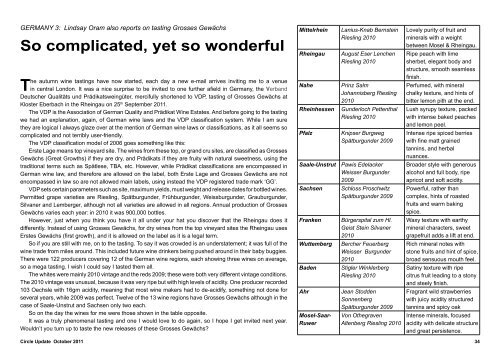You also want an ePaper? Increase the reach of your titles
YUMPU automatically turns print PDFs into web optimized ePapers that Google loves.
GERMANY 3: Lindsay Oram also reports on tasting Grosses GewächsSo complicated, yet so wonderfulThe autumn wine tastings have now started, each day a new e-mail arrives inviting me to a venuein central London. It was a nice surprise to be invited to one further afield in Germany, the VerbandDeutscher Qualitäts und Prädikatsweingüter, mercifully shortened to VDP, tasting of Grosses Gewächs atKloster Eberbach in the Rheingau on 25 th September 2011.The VDP is the Association of German Quality and Prädikat Wine Estates. And before going to the tastingwe had an explanation, again, of German wine laws and the VDP classification system. While I am surethey are logical I always glaze over at the mention of German wine laws or classifications, as it all seems socomplicated and not terribly user-friendly.The VDP classification model of 2006 goes something like this:Erste Lage means top vineyard site. The wines from these top, or grand cru sites, are classified as GrossesGewächs (Great Growths) if they are dry, and Prädikats if they are fruity with natural sweetness, using thetraditional terms such as Spätlese, TBA, etc. However, while Prädikat classifications are encompassed inGerman wine law, and therefore are allowed on the label, both Erste Lage and Grosses Gewächs are notencompassed in law so are not allowed main labels, using instead the VDP registered trade mark ‘GG’.VDP sets certain parameters such as site, maximum yields, must weight and release dates for bottled wines.Permitted grape varieties are Riesling, Spätburgunder, Frühburgunder, Weissburgunder, Grauburgunder,Silvaner and Lemberger, although not all varieties are allowed in all regions. Annual production of GrossesGewächs varies each year: in 2010 it was 900,000 bottles.However, just when you think you have it all under your hat you discover that the Rheingau does itdifferently. Instead of using Grosses Gewächs, for dry wines from the top vineyard sites the Rheingau usesErstes Gewächs (first growth), and it is allowed on the label as it is a legal term.So if you are still with me, on to the tasting. To say it was crowded is an understatement; it was full of thewine trade from miles around. This included future wine drinkers being pushed around in their baby buggies.There were 122 producers covering 12 of the German wine regions, each showing three wines on average,so a mega tasting. I wish I could say I tasted them all.The whites were mainly 2010 vintage and the reds 2009; these were both very different vintage conditions.The 2010 vintage was unusual, because it was very ripe but with high levels of acidity. One producer recorded103 Oechsle with 16gm acidity, meaning that most wine makers had to de-acidify, something not done forseveral years, while 2009 was perfect. Twelve of the 13 wine regions have Grosses Gewächs although in thecase of Saale-Unstrut and Sachsen only two each.So on the day the wines for me were those shown in the table opposite.It was a truly phenomenal tasting and one I would love to do again, so I hope I get invited next year.Wouldn’t you turn up to taste the new releases of these Grosses Gewächs?MittelrheinRheingauNaheRheinhessenPfalzSaale-UnstrutSachsenFrankenWuttembergBadenAhrMosel-Saar-RuwerLanius-Knab BernsteinRiesling 2010August Eser LenchenRiesling 2010Prinz SalmJohannisberg Riesling2010Gunderloch PettenthalRiesling 2010Knipser BurgwegSpätburgunder 2009Pawis EdelackerWeisser Burgunder2009Schloss ProschwitzSpätburgunder 2009Bürgerspital zum Hl.Geist Stein Silvaner2010Bercher FeuerbergWeisser Burgunder2010Stigler WinklerbergRiesling 2010Jean StoddenSonnenbergSpätburgunder 2009Von OthegravenAltenberg Riesling 2010Lovely purity of fruit andminerals with a weightbetween Mosel & Rheingau.Ripe peach with limesherbet, elegant body andstructure, smooth seamlessfinish.Perfumed, with mineralchalky texture, and hints ofbitter lemon pith at the end.Lush syrupy texture, packedwith intense baked peachesand lemon peel.Intense ripe spiced berrieswith fine matt grainedtannins, and herbalnuances.Broader style with generousalcohol and full body, ripeapricot and soft acidity.Powerful, rather thancomplex, hints of roastedfruits and warm bakingspice.Waxy texture with earthymineral characters, sweetgrapefruit adds a lift at end.Rich mineral notes withstone fruits and hint of spice,broad sensuous mouth feel.Satiny texture with ripecitrus fruit leading to a stonyand steely finish.Fragrant wild strawberrieswith juicy acidity structuredtannins and spicy oakIntense minerals, focusedacidity with delicate structureand great persistence.<strong>Circle</strong> <strong>Update</strong> October 2011 34


